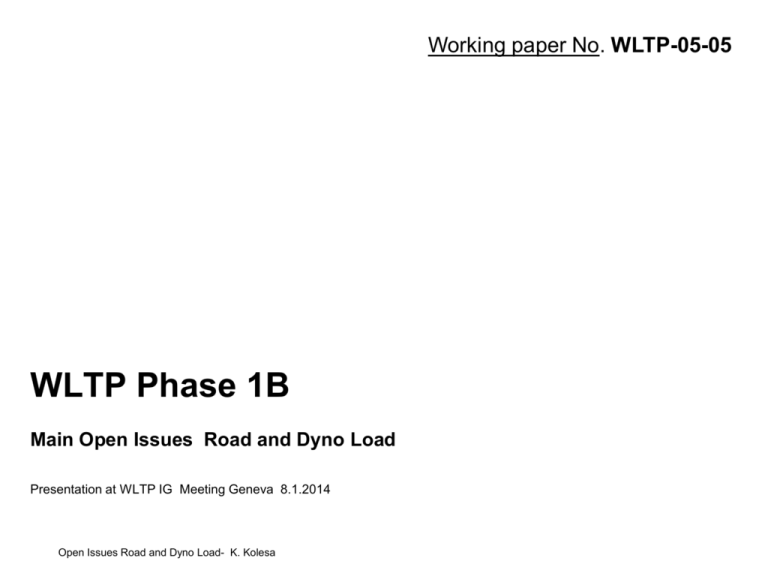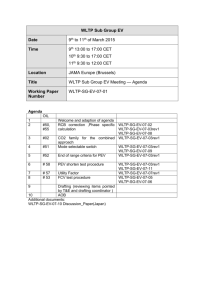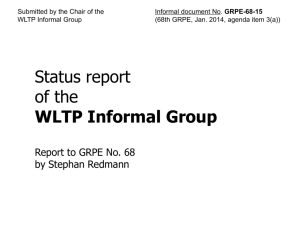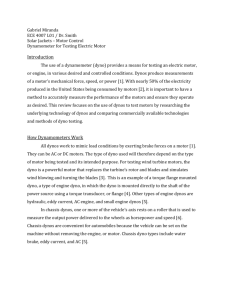WLTP-05-05 - Phase1B key issues RLD
advertisement

Working paper No. WLTP-05-05 WLTP Phase 1B Main Open Issues Road and Dyno Load Presentation at WLTP IG Meeting Geneva 8.1.2014 Open Issues Road and Dyno Load- K. Kolesa Open Issues Phase 1B for WLTP Road and Dyno Load 3.2. wind tunnel criteria 4 4.1. wind conditions general review for on board anemometry 4 4.3. coast down procedure review of definitions and selection of speed range, speed points, reference speeds for RLD and dyno load setting 4 4.3.2. on board anemometry based review of the method (comments IR 85 coast down method e.g. 87, 92) 4.3.2.6.1. 4 4.4. torque meter method 4.4.2.2. torque meter method 4 4.5.5. road load curve correction 4 5.2. default road load parameter 4 6. 4 7.3.4. wind tunnel method for RLD alternative warm up procedure 4 8.2.3.2. 4, App. 2.3. 1 2 general review required 4 chassis dyno load setting with torque meter method close link to #18 validation measurements required to be discussed, then modify if necessary to be developed YES NO YES NO NO to be reviewed, then modify if necessary ascending ? or descending ? to be decided to be reviewed, use always three coefficients, formulae to then modify if be developed (comments IR 101 - 103) necessary Industry objects to current parameters. to be reviewed, Based of future data the parameters can then modify if be reviewed and adapted necessary (LabProcICEdoc 269) method to be developed to be developed YES definition of family or procedure NO general review of torque meter method (comment IR 95, IR 132) to be developed review and/or development of a method with 3 coefficients, to be reviewed, 10 N criteria to be checked/applied then modify if transfer of road to dyno load - clarification necessary needed The simulated road load calculation for each reference postpone to phase-1b speed v_j Titel oder Name, Abteilung, Datum Open Issues Road and Dyno Load- K. Kolesa to be reviewed, then modify if necessary NO NO NO NO NO NO On-Board Anemometry for RLD WLTP Annex 4 § 4.1.1.1.2 ► Road load determination of vehicles on road has to consider actual wind influence by measuring ambient wind speeds . For low wind speeds a stationary anemometry is sufficient. Measuring under higher wind speed conditions is only allowed using onboard wind speed measurement. ► This anemometry method is of regional importance using test tracks with a more open structure and higher wind speed conditions. Therefore this method was introduced in WLTP. ► The maximum permissible wind speed conditions were discussed at length in Phase 1A and it was concluded to perform further investigations in accuracy of correction functions to obtain a robust and equivalent anemometry method. ► Contact persons. A. Rijnders (NL) and C. Hosier (OICA) Initial proposal is expected in meeting # 8, final decision in meeting #8 3 Open Issues Road and Dyno Load- K. Kolesa Windtunnel Criteria WLTP Annex 4 § 3.2 ► Background: The combined approach is based on measurement data for the vehicle with lowest and highest cycle energy demand. The vehicles between these extremes can be measured or calculated with data of mass, tire rolling resistance and aerodynamic resistance of available options. ► Aerodynamic data of available options can be measured on road with a high uncertainty or better in a wind tunnel. Therefore basic criteria for windtunnel characteristics were introduced in WLTP. ► Discussions with CP revealed need for a further review of these criteria as some windtunnel actually cannot fulfill the requirements. Especially the requirement for moving ground belt and the air pressure coefficient have to be discussed with CP’s. ► Contact Person: BMW Initial proposal expected at WLTP meeting #8, decision in meeting #12 4 Windtunnel / Chassis dyno as alternative RLD method WLTP Annex 4 § 6 ► Current WLTP provides 4 methods for road load determination: 1. Coast down method 2. Torquemeter method 3. Use of windtunnel/Chassis Dyno 4. Calculation of road load based on vehicle parameters ► Method (3) was reserved in gtr, but not developed yet. ► Measurement principle: Driving resistance of vehicles on road is caused by aerodynamic drags and resistance of tires and mechanical/electrical drags. Vehicle aerodynamic resistance is measured in wind tunnel with specified characteristics, rolling resistance is determined at chassis dynamometer equipment. The discrete evaluated forces can be superposed to obtain the driving resistance. ► Accuracy is expected to be far better than on road measurements due to lack of influencing ambient factors, like wind, road, temperatures. ► Critical is the definition of windtunnel and chassis dyno equipment. The equivalency to the method 1 has to be shown by validation testing. Calibration for measurement equipment is to be defined. ► Contact Person is BMW, initial proposal is expected in WLTP meeting #6, decision in meeting #12 5 Open Issues Road and Dyno Load- K. Kolesa Torque meter method as alternative RLD method WLTP Annex 4 § 4.4 ► Current WLTP provides 4 methods for road load determination: 1. Coast down method 2. Torquemeter method 3. Use of windtunnel/Chassis Dyno 4. Calculation of road load based on vehicle parameters ► Method (2) was introduced as an alternative method to coasting down a vehicle ► Measurement principle: Driving resistance of vehicles on road is caused by aerodynamic drags and resistance of tires and mechanical/electrical drags. Vehicle aerodynamic resistance is measured at constant speed points and the energy demand for superseding the driving resistance is determined by special torquemeters between driving axle and tire. ► Advantage is measurement of driving resistance under positive torque. Parasitic drags (e.g. electric braking or regeneration) during deceleration phase of vehicle can be avoided. ► Critical is the validation of equivalency to coast down method. Validation testing required. Calibration of measurement equipment is to be validated. ► Contact person are TNO and C. Hosier (OICA) , initial proposal is expected in WLTP meeting #9, decision in meeting #9. 6 Alternative Warming Up Procedure on Dyno WLTP Annex 4 § 7.3.4 ► Background: Road Load of vehicle has to be simulated on chassis dyno to obtain similar conditions as in real life. For comparison of dyno load with road load the vehicle has to be in comparable temperature conditions ► Current WLTP provides a prescription for warming up the vehicle preceding dyno load determination ► For alternative warming up procedures the equivalency criteria and the applicable family definition have to be reviewed. ► Contact Person: Yamaguchi, Japan Initial Proposal expected at WLTP meeting #6, final decision in meeting#7 7 Open Issues Road and Dyno Load- K. Kolesa Calculation of default road load based on vehicle parameters WLTP Annex 4, § 5 ► As an alternative for determining road load with the coast down or torque meter method , a calculation method for default road load parameters may be used. ► Situation: Industry objects to current defined parameters. Based on future data the parameters can be reviewed and adapted ► Contact Person: A. Rijnders (NL) Initial proposal expected in WLTP meeting #8, final decision in meeting #9 8 Open Issues Road and Dyno Load- K. Kolesa



